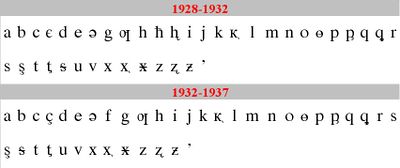Lak language
| Lak | ||
|---|---|---|
| лакку маз (lakːu maz) | ||
| Spoken in | ||
| Total speakers | 157,000 (2002)[1] | |
| Language family | Northeast Caucasian
|
|
| Writing system | Cyrillic (Lak variant) | |
| Official status | ||
| Official language in | ||
| Regulated by | No official regulation | |
| Language codes | ||
| ISO 639-1 | None | |
| ISO 639-2 | cau | |
| ISO 639-3 | lbe | |
| Linguasphere | ||
| Note: This page may contain IPA phonetic symbols in Unicode. | ||
The Lak language (лакку маз, lakːu maz) is a Northeast Caucasian language forming its own branch within this family. It is the language of the Lak people from the Russian autonomous republic of Dagestan, where it is one of six literary languages. It is spoken by about 157,000 people.
In the past it was also referred to as Gazi-Qumuq (Гьази-Кьумукь), which was transliterated via Russian as Kazi-Kumukh (Кази-Кумук) or Kasi-Kumukh (Каси-Кумук), where Gazi or Kasi means - Worrior for faith. The literary standard is based on the dialect of the city of Kumukh. This city should not be confused with the ethnic group, also present in the Caucasus. Other major dialects are the Arakul, Shadnin, Khosrekh, and Vitskhi (Wicxi, Vicxi) dialects.
Lak has throughout the centuries adopted a number of loanwords from Arabic, Turkish, Persian, and Russian. Ever since Dagestan was part of the USSR and later Russia, the largest portion of loanwords have come from Russian, especially political and technical vocabulary.
There is a newspaper [2] and broadcasting station in Lak.
Contents |
Phonology
Vowels
Consonants
| Labial | Dental | Alveolar | Palatal | Velar | Uvular | Epi- glottal |
Glottal | |||||||||||||
|---|---|---|---|---|---|---|---|---|---|---|---|---|---|---|---|---|---|---|---|---|
| plain | lab. | plain | lab. | plain | lab. | |||||||||||||||
| lenis | fortis | lenis | fortis | lenis | fortis | lenis | fortis | lenis | fortis | lenis | fortis | lenis | fortis | lenis | fortis | |||||
| Nasal | m | n | ||||||||||||||||||
| Plosive | voiced | b | d | ɡ | gʷ | ʡ | ||||||||||||||
| voiceless | p | pː | t | tː | k | kː | kʷ | kːʷ | q | qː | qʷ | qːʷ | ʔ | |||||||
| ejective | pʼ | tʼ | kʼ | kʷʼ | qʼ | qʷʼ | ||||||||||||||
| Affricate | voiceless | t͡s | t͡sː | t͡ʃ | t͡ʃː | t͡ʃʷ | t͡ʃːʷ | |||||||||||||
| ejective | t͡sʼ | t͡ʃʼ | t͡ʃʷʼ | |||||||||||||||||
| Fricative | voiceless | s | sː | ʃ | ʃː | ʃʷ | ʃːʷ | x | xː | xʷ | xːʷ | χ | χː | χʷ | χːʷ | ʜ | h | |||
| voiced | v ~ w ~ ʙ |
z | ʒ | ʒʷ | ʁ | ʁʷ | ||||||||||||||
| Trill | r | |||||||||||||||||||
| Approximant | l | j | ||||||||||||||||||
- The consonants in orange are given by Schulze, but not by TITUS. The consonant in grey is given by TITUS, but not by Schulze.
- The sound transcribed here as a glottal stop is named rather ambiguously a "glottalic laryngeal" by both sources.
- Note that both sources name the epiglottal series ″pharyngeal″ indiscriminately in all the tables, the first one also when it includes a plosive and thus cannot be a true pharyngeal.
Writings systems
Until 1928, the Arabic script was used to write the language. Afterwards it was written with a Latin alphabet for ten years, and since 1938 it has been written with the Cyrillic alphabet.
| А а | Аь аь | Б б | В в | Г г | Гъ гъ | Гь гь | Д д |
| Е е | Ё ё | Ж ж | З з | И и | Й й | К к | Къ къ |
| Кь кь | КI кI | Л л | М м | Н н | О о | Оь Оь | П п |
| ПI пI | Р р | С с | Т т | ТI тI | У у | Ф ф | Х х |
| Хъ хъ | Хь хь | ХI хI | Ц ц | ЦI цI | Ч ч | ЧI чI | Ш ш |
| Щ щ | Ъ ъ | Ы ы | Ь ь | Э э | Ю ю | Я я | I |

References
External links
- Lak Grammar by Wolfgang Schulze
- Lak writing systems
- Lak House — Lak culture and society site
- Лакку Билаят — Lak national forum
|
|||||||||||